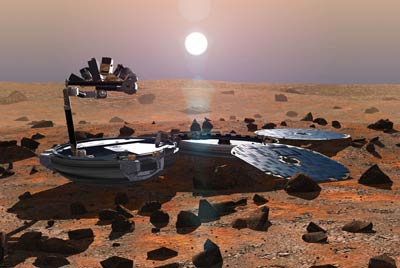Found dogby Dwayne A. Day
|
| The investigation specifically ruled out the Mars atmosphere explanation and although it could not pinpoint the cause of failure, the report laid the blame on management. It is in many ways a case study in how not to build a spacecraft. |
Beagle 2 has an interesting story: It started out in the latter 1990s as a “private” spacecraft. British scientist Colin Pillinger raised money to build it and have it attached to a larger European Space Agency (ESA) spacecraft named Mars Express, gaining approval in November 1999. In order to drum up support for his project, Pillinger frequently badmouthed NASA, saying that NASA’s Mars spacecraft were expensive and bloated and he would show that a Mars lander could be built for relatively little money, privately. But Pillinger ran into fundraising problems and ended up having the British government bail him out. He also may have ended up stiffing his aerospace contractor with an unpaid bill. Eventually the British government grew nervous enough about the mission that it sought help from some Mars experts at the Jet Propulsion Laboratory (JPL)—the very people that Pillinger had been ridiculing earlier. All of this should sound like a familiar tune, from the “private” operation that relies upon a government bailout to bashing the experts until it becomes necessary to enlist their help.
Mars Express launched in June 2003 and arrived at the Red Planet in December, and still operates there today. Beagle 2 had no system for sending telemetry during its descent, so once it separated from Mars Express there was no way of knowing what happened to it until it activated itself on the Martian surface. When that didn’t happen, Pillinger blamed the Martian atmosphere, which he said had gotten unpredictably thin at the landing site, dooming Beagle 2. Pillinger’s explanation became the standard public explanation repeated in the media, and he began trying to raise money for Beagle 3.
Following Beagle 2’s loss, the UK Minister of Science and Innovation and the ESA Director General then created a “Commission of Inquiry” to investigate it. They produced their report in April 2004. Their 42-page inquiry makes for interesting reading. In bureaucratic tones it is quite damning, recounting numerous problems in Beagle’s development, testing shortcuts, and potential causes of failure. The investigation specifically ruled out the Mars atmosphere explanation and although it could not pinpoint the cause of failure, the report laid the blame on management. It is in many ways a case study in how not to build a spacecraft.
 An illustration of how Beagle 2 was to appear had it landed safely and deployed properly. (credit: Beagle 2) |
But after the commission produced the report and reporters asked when they would see it, ESA and the British National Space Centre (which helped fund Beagle 2 when Pillinger could not raise sufficient private funding) refused to release it. According to a BNSC statement, “the report was always seen by BNSC and ESA as an internal inquiry. Its purpose was to learn lessons for the future”—something that would be difficult to do if nobody could actually see the report. The report contained 19 recommendations, and BNSC released the recommendations, but not any of the evidence to support them.
David Southwood, the head of science for ESA, when told by reporters that NASA did not suppress its failure investigations, declared, “We live in an open society too, but it’s open in a different way.” That openness involved secrecy. He provided no reasons such as national security, trade secrets, or proprietary data. (See “A Different kind of openness”, The Space Review, February 28, 2005.)
Fortunately, Britain has a freedom of information law that includes the sensible requirement that the government needs a reason other than covering up embarrassments to keep information secret. The magazine New Scientist sued and the report was released in January 2005—and in fine bureaucratic form, the British government acted like it was their idea to release it all along (that is, no mention of that pesky lawsuit.) And after a few news stories, Beagle 2 was forgotten. Pillinger was never able to raise money for a follow-on spacecraft. He died in May 2014 at age 70.
And now Beagle 2 has been found. So what can we learn?
There are engineering practices and techniques that should not be ignored
Spotting the spacecraft more or less intact on Mars’ surface is an important data point. It indicates that the spacecraft survived reentry intact and its parachute system operated. Some of its solar panels appear to have deployed as well. It is possible that some event during entry, descent, and landing may have caused internal damage that prevented it from fully deploying and operating. Those familiar with Beagle 2’s design may be able to make some better guesses about possible failures or, at the very least, rule out some causes.
| What if the addition of a backup system on Beagle 2 would have enabled the activation of the communications system? What if the elimination of a relatively inexpensive system caused the entire mission to fail? |
One of the primary reasons it was so important to release the Beagle 2 failure investigation back in 2005 was so that it can be taught in engineering schools and used as a guide for future spacecraft development. It provided a litany of things not to do. Some of those lessons are familiar ones to NASA, which learned them in the late 1990s, like “don’t skimp on testing.”
As the investigation report demonstrated, lessons cannot simply be learned once. They have to be learned again and again, both because people forget, devalue, or ignore them, and because new people are always entering the field. One of the investigation report’s recommendations was to provide telemetry during entry, descent and landing—a lesson NASA had applied after its Mars mission failures but the Beagle 2 team ignored. A British undergrad entering engineering school today may have no memory of Beagle 2’s failure over a decade ago, so making him read the report will be a valuable training tool.
Inquiry and introspection are inherently valuable
Another lesson is the value of lesson-learning itself, of inquiry. Right now NASA and JPL are conducting advanced design work and preliminary construction of the Mars 2020 rover, which will use the entry, descent, and landing system and rover systems developed for the Curiosity rover currently on Mars. NASA and JPL have a long string of technical successes at Mars. But there is more to success than just technical accomplishments. Curiosity has been a success, but it ran significantly over-budget and behind schedule, slipping its launch date by a full Mars window from 2009 to 2011, which cost NASA over $400 million—the equivalent of another small spacecraft. Another way of putting that is that managerial failures with Curiosity cost NASA another, unbuilt, spacecraft.
Has JPL learned the lessons of the Curiosity development? Certainly many people working on Curiosity probably believe they have, and there have been public “lessons learned” presentations about Curiosity by project engineers. But have they really learned Curiosity’s lessons? Many of the important lessons are not technical, but managerial, such as how soon managers could have realized that they were not going to make the 2009 launch window and throttled back on the funding instead of slamming the pedal to the floor. Somewhere inside JPL there probably exists a thick report on lessons learned from Curiosity, and that report is more useful if it is widely shared, and taught, not only in the halls of JPL but in engineering schools across the country. That lesson can feed forward to future spacecraft designs, and to young engineers who are only now starting to learn about systems engineering and program management.
Beware when cutting corners in spaceflight
Based upon the imagery, it looks like Beagle 2 may have deployed some of its solar panels but did not uncover its communication system. At least one person has already commented on the Internet that Beagle 2 is “fully operational” except for the communication system. There is no way to know that, and it is possible that even if the communications system had deployed there were other problems with the spacecraft. When spacecraft are designed small and inexpensively, one of the first design decisions is to eliminate redundancy. Instead of two systems, you include only one and save money, mass, and complexity. What if the addition of a backup system on Beagle 2 would have enabled the activation of the communications system? What if the elimination of a relatively inexpensive system caused the entire mission to fail?
Cost is not the only or even the most important factor
Even if Beagle 2 had operated successfully, it would be a mistake to claim that it was somehow equivalent to the far more sophisticated, ambitious, and scientifically valuable spacecraft that NASA has sent to Mars. It is common for members of the public and the media to make comparisons of spacecraft based primarily on cost and not on capabilities or quality.
| Why exactly did Beagle 2 fail? That mystery could serve as a great learning exercise for both new and experienced spacecraft designers. |
For example, just last year India successfully deployed its Mars Orbiter Mission spacecraft around Mars. This was an impressive accomplishment, especially for a first try. Many media articles compared the Indian spacecraft to NASA’s MAVEN Mars orbiter by noting that the Indian spacecraft was considerably cheaper. Setting aside the fact that the Indian cost figures are not credible (by the Indian space agency’s own admission they exclude many costs, like engineers’ salaries), the Indian mission carries few, relatively simple instruments, and was primarily a small engineering test spacecraft, not a full-scale scientific spacecraft. NASA’s missions are designed to answer important scientific questions, and designed with greater redundancy.
Bloated and expensive programs are not good for space science, but cheap spacecraft that don’t answer scientific questions do not have much utility of their own. The important factor is not the cost, but what the mission accomplishes for the money spent. NASA’s Mars spacecraft have been outstanding in this regard. On January 25, the Opportunity rover will mark its eleventh year operating on Mars.
Learning lessons from an old dog
With this new data from Mars we also have a new mystery. Why exactly did Beagle 2 fail? That mystery could serve as a great learning exercise for both new and experienced spacecraft designers. It serves as a reminder that even when we think we know what we need to know, we should still evaluate our assumptions.
Beagle 2, silent for more than 11 years, has things to tell us still.
